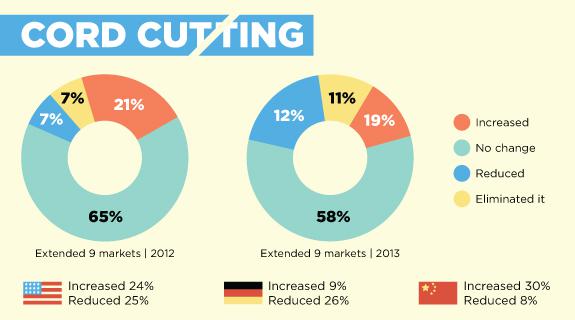Cord-cutting is on the rise, but regularly scheduled broadcast TV viewing has remained fairly stable, according to Ericsson’s ConsumerLab TV & Media 2013 Study.
100,000 people were surveyed on their current TV habits for the study, across more than a dozen countries. More than 80% of those surveyed watch scheduled broadcast TV on a more than weekly basis (up slightly from last year), while on the cord-cutting side, 25% of US viewers surveyed said they reduced or eliminated their TV package within the past year. Across a sample of nine other countries, 23% also professed to reducing the size of their pay-TV package, compared to only 14% one year ago.
Mobile devices are also, not surprisingly, becoming more and more important as options for TV content, the study showed. More than 70% of respondents use mobile devices for viewing video content at least once per week, with 42% using them outside the home. While watching content on other screens, 75% multitask with their mobile devices, and 25% watch more than one video source simultaneously.More than 60% stream online time-shifted content on a more than weekly basis—up from 61% in 2011.
One aspect of the study was focused on late adopters, an oft-overlooked demographic but a key indicator that on-demand and streaming are becoming mainstream trends. According to Ericsson, 71% of the 25-34 age group stream on-demand or time-shifted content more than once a week, as well as 48% of those 45-54 and 41% of those 65-69.
Brief Take: While cord cutting remains a growing issue for the pay TV industry, broadcast TV viewing is in no immediate danger… for now.
Tags:













































__twocolumncontent.jpg)











